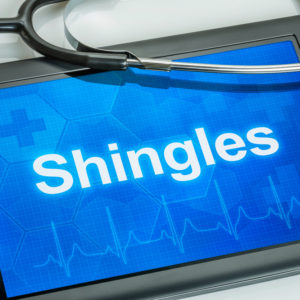Doctors’ Notes
BackShingles
Shingles is a viral illness rash that is caused by the Varicella Zoster Virus, a virus that is also responsible for the once common and dreaded chickenpox. Any person who has previously recovered from chickenpox can later be afflicted with shingles.

After you recover from chicken pox, the virus, instead of just going away, goes dormant in your body. You aren’t sick, because the virus is inactive. But the virus hides in your body waiting for the opportune moment to torment you again. Fortunately, only 1 and 3 people will experience a reactivation of the virus. But if it does reactivate, it’s known as shingles.
Anyone can get shingles, including children, although it’s very rare for a child to develop shingles. Most people who get shingles are over 50, have a weakened immune system, and/or are under considerable emotional stress.
Symptoms
Shingles is characterized by a painful, red, blistering rash, which usually occurs in a very specific pattern. The shingles rash usually limits itself to one side of the body, appearing like a band that follows a single dermatome, which are areas of skin supplied by a specific spinal nerve. The rash usually appears on the trunk or face. Sometimes a burning sensation, pain, itching, or tingling sensation precede eruption of the rash. Fever, chills, fatigue, headache, and upset stomach can also be experienced.
Is it Contagious?
Yes and no.
Shingles is not contagious, but the varicella zoster virus that causes shingles can be spread through direct contact with fluid from the rash when the blisters rupture. It can take up to 5 weeks for the rash to resolve completely, but once the blisters are done oozing and crust over, they’re no longer contagious.
If you’ve never had chicken pox and become infected with the varicella zoster virus after being in contact with someone with shingles, you will not get shingles, but instead develop chicken pox. Of course, after contracting chicken pox, you’re susceptible to having shingles later in life.
Treatment
Shingles is a virus, so there is no cure, and antibiotic therapy will be of no benefit. Treatment is instead aimed at limiting the severity and duration of symptoms. Several antiviral medicines, such as acyclovir and valacyclovir, can be helpful if started as early as possible.
Early treatment is particularly important if shingles occurs on the face and involves the eyes or ears, as this can lead to serious problems. In addition to antiviral therapy, OTC and prescription pain medicine, antihistamines, calamine lotion, oatmeal baths, and compresses can also help ease your symptoms. You usually feel better in about 10 days, but it can take several weeks for the rash to clear up completely. Although it’s not impossible, people rarely have shingles a second time.
Prevention
The best way to prevent shingles is make sure you and your children stay up-to-date on your vaccines. Since 1995, a vaccine for chicken pox has been available that is around 90 percent effective.
If you never get chicken pox, you will never get shingles, and it’s never too late to receive the varicella vaccine. It is also important to note that if you are not vaccinated, getting a chickenpox vaccine before pregnancy can be an important step in protecting your child, because contracting chicken pox during pregnancy can result in congenital disabilities.
For those of you over 50, a shingles vaccine can be administered that prevents shingles 90 percent of the time. If you or an acquaintance have an active chicken pox/shingles infection, the most important thing you can do to limit the risk of spreading the virus is to keep your rash covered.
Michael Durkin, PA-C, has been a Kids Plus Provider since 2019.